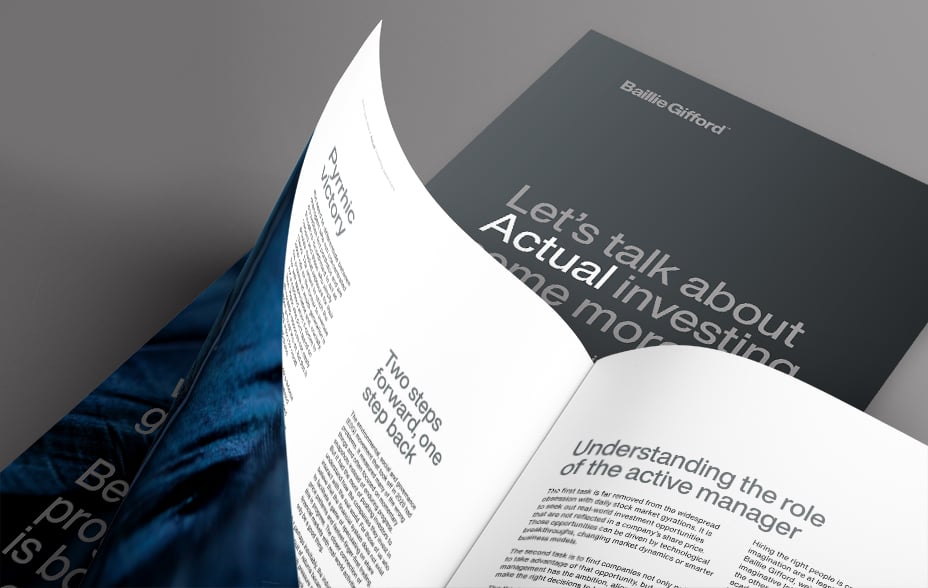
Listen to this article
This audio is generated using AI
Your capital is at risk.
China faces many challenges. But extrapolating from its current weakness is a mistake.
To understand the country’s potential, look to nature. After Moso bamboo germinates, there can be little visible growth for years as the plant develops a robust root system. Then, using biological mechanisms that remain a mystery, it can shoot up faster than 1m a day to become more than 15 times the height of an adult human and harder than oak.
Likewise, China’s current growth might seem relatively anaemic – GDP growth has cooled, home prices are falling, consumer sentiment is weak and its population is shrinking. Coupled with concerns over geopolitical risk and regulatory intervention, it is understandable why international investors are sceptical. But below the surface, China’s government and companies are laying the foundations for the next growth phase.
They include the economy’s transition from property and infrastructure to advanced manufacturing. This involves developing capabilities in areas such as semiconductors, robotics and artificial intelligence and is described as ‘high-quality development’. If done well, it will boost China’s long-term productivity and growth, offsetting the shrinkage of its working-age population.
Battle-tested companies
Investing in China, however, is difficult. Of the roughly 8,000 listed China-based companies, only about 600 have made an average return on capital of more than 10 per cent over the last five years. Put differently, more than 90 per cent of the market hasn’t generated enough returns to justify shareholders’ investment over the period.
Why has long-term performance been so poor? In large part because competition is so intense.
This is a market where change is rapid, capital abundant, consumers fickle and competitive advantage fluid. Furthermore, its scale – a population of over 1.4 billion, an extensive manufacturing base and a rising middle class – also makes it highly attractive to copycats.
While Tesla practically had the electric vehicle (EV) market to itself in the US for years, rivals proliferated in China from almost the start. At one point, Bloomberg reported there were “roughly 500” registered firms involved.

CATL’s batteries are widely used by Chinese and western electric vehicle makers
That competition eroded returns, but it also weeded out the weakest players. Those that survived, such as Li Auto, and their suppliers, including battery maker CATL, are now world-class operators capable of thriving on the global stage.
Overcapacity by design
Some still write off China’s EV industry and other emerging sectors because of overcapacity. As we’ve repeatedly seen in the country, when production exceeds demand, prices fall and profits are squeezed or wiped out. This can cause investors to take fright.
However, for technologies that follow Wright’s Law – the rule-of-thumb that says for each doubling in production, the cost of manufacturing each unit decreases by a constant percentage – overcapacity can create the conditions for long-term competitive advantage. In simple terms, the more you make, the more ways you learn to improve the processes involved, allowing you to increase quality and cut unit costs simultaneously.
It’s how Taiwanese chip manufacturer TSMC leapfrogged its American and Japanese counterparts. And it’s a significant factor in why Chinese firms account for 80 per cent of the world’s solar panel production.
Moreover, adoption curves in new industries tend to be highly predictable, suggesting that the demand for China’s EVs will continue to increase to match the expanding production capacity.
‘Overcapacity’ in newly emerging industries is, therefore, a feature, not a bug. It’s a result of deliberate policies by the Chinese government to build a competitive lead in strategic industries. These policies spur innovation, increase output and reduce prices.
Lower prices benefit consumers and accelerate EV adoption. EV penetration in China will probably exceed 40 per cent this year, compared to a global figure of about 10 per cent.
The move to EVs also has other consequences. It reduces reliance on foreign oil. It cuts pollution and increases air quality. And it creates jobs.
Decoupling’s implications
No conversation about China is complete without touching on geopolitics. However, it would be misguided to group all concerns under the umbrella term ‘China risk’ and suggest you can avoid it by only investing elsewhere.
The US and China’s economies are tightly integrated and mutually dependent. This increases the cost of conflict, discouraging hostile action.
However, in the medium term, rising trade barriers and firms’ acting to localise supply chains could accelerate economic decoupling, reducing the deterrent. This would create risks not only for Chinese companies but also businesses selling into China.
Take, for example, what we’re already seeing with semiconductor localisation. China is the largest chip consumer, purchasing more than half the world’s supply, most of which it imports.
In 2015, its government set targets to reduce that reliance. This became more pressing when Washington introduced semiconductor export restrictions against first telecoms specialist Huawei, then chip manufacturer SMIC, and ultimately across China. Covid added further impetus when many semiconductor makers prioritised orders from large western companies over smaller Chinese ones.
China may never bridge the technology gap in leading-edge logic – processors that act as the ‘brains’ of smartphones, computer servers and artificial intelligence hardware. However, most of the volume is in trailing-edge chips.
Chinese firms are set to commoditise power semiconductors, which control and convert electrical voltage in everything from vehicles to industrial systems and power grids. Next, they could seek to manufacture their own analog chips, which handle real-world signals – including sound, heat, and light – in sensors, medical equipment and other devices. These markets are currently dominated by western firms.

Chinese semiconductor firms are likely to gain ground in trailing-edge chips, including those used to regulate voltage
The takeaway is that western companies are just as exposed to geopolitical risk as Chinese ones. Moreover, as the US and EU consider fresh tariffs on Chinese EVs and energy transition products to protect their domestic industries, this could spiral into a broader trade war.
One obvious target for Chinese retaliation would be western luxury goods. Given that China is the world’s second-biggest market for these products after the US, many companies would find it difficult to avoid the fallout.
Cultivating new growth
The emergence of the Chinese economy has arguably been the greatest economic event since the Industrial Revolution.
Just 25 years ago, the nation accounted for about 3 per cent of the world’s GDP. Today, it’s about 17 per cent, second only to the US. And we expect its rise to continue – not just in terms of economic metrics but also in measures of technological power and advanced manufacturing capability.
For all the complexities that investing in China brings, as a global investor, you cannot ignore it. China will become an increasingly important actor in the global economy. It is tightly woven into international supply chains, being the largest trading partner for eight of the world’s 10 largest economies. Its policies have far-reaching implications for global companies. And its interests and activities span multiple continents.
So, what for portfolios? Returning to my earlier analogy, Moso bamboo has another unusual characteristic. Groves can go more than a century between flowerings. But when they do, each mature stem is prolific in its release of seeds, unleashing fresh growth.
Could China’s investments in advanced manufacturing set the country up for such a rare flowering? What might that mean for the changing world order? If there is one thing I have the highest conviction in it’s that you cannot hope to understand the world without understanding China.
Risk factors
The views expressed should not be considered as advice or a recommendation to buy, sell or hold a particular investment. They reflect opinion and should not be taken as statements of fact nor should any reliance be placed on them when making investment decisions.
This communication was produced and approved in September 2024 and has not been updated subsequently. It represents views held at the time of writing and may not reflect current thinking.
This communication contains information on investments which does not constitute independent research. Accordingly, it is not subject to the protections afforded to independent research, but is classified as advertising under Art 68 of the Financial Services Act (‘FinSA’) and Baillie Gifford and its staff may have dealt in the investments concerned.
All information is sourced from Baillie Gifford & Co and is current unless otherwise stated.
The images used in this communication are for illustrative purposes only.
Important Information
Baillie Gifford & Co and Baillie Gifford & Co Limited are authorised and regulated by the Financial Conduct Authority (FCA). Baillie Gifford & Co Limited is an Authorised Corporate Director of OEICs.
Baillie Gifford Overseas Limited provides investment management and advisory services to non-UK Professional/Institutional clients only. Baillie Gifford Overseas Limited is wholly owned by Baillie Gifford & Co. Baillie Gifford & Co and Baillie Gifford Overseas Limited are authorised and regulated by the FCA in the UK.
Persons resident or domiciled outside the UK should consult with their professional advisers as to whether they require any governmental or other consents in order to enable them to invest, and with their tax advisers for advice relevant to their own particular circumstances.
Financial Intermediaries
This communication is suitable for use of financial intermediaries. Financial intermediaries are solely responsible for any further distribution and Baillie Gifford takes no responsibility for the reliance on this document by any other person who did not receive this document directly from Baillie Gifford.
Europe
Baillie Gifford Investment Management (Europe) Ltd (BGE) is authorised by the Central Bank of Ireland as an AIFM under the AIFM Regulations and as a UCITS management company under the UCITS Regulation. BGE also has regulatory permissions to perform Individual Portfolio Management activities. BGE provides investment management and advisory services to European (excluding UK) segregated clients. BGE has been appointed as UCITS management company to the following UCITS umbrella company; Baillie Gifford Worldwide Funds plc. BGE is a wholly owned subsidiary of Baillie Gifford Overseas Limited, which is wholly owned by Baillie Gifford & Co. Baillie Gifford Overseas Limited and Baillie Gifford & Co are authorised and regulated in the UK by the Financial Conduct Authority.
China
Baillie Gifford Investment Management (Shanghai) Limited 柏基投资管理(上海)有限公司(‘BGIMS’) is wholly owned by Baillie Gifford Overseas Limited and may provide investment research to the Baillie Gifford Group pursuant to applicable laws. BGIMS is incorporated in Shanghai in the People’s Republic of China (‘PRC’) as a wholly foreign-owned limited liability company with a unified social credit code of 91310000MA1FL6KQ30. BGIMS is a registered Private Fund Manager with the Asset Management Association of China (‘AMAC’) and manages private security investment fund in the PRC, with a registration code of P1071226.
Baillie Gifford Overseas Investment Fund Management (Shanghai) Limited柏基海外投资基金管理(上海)有限公司(‘BGQS’) is a wholly owned subsidiary of BGIMS incorporated in Shanghai as a limited liability company with its unified social credit code of 91310000MA1FL7JFXQ. BGQS is a registered Private Fund Manager with AMAC with a registration code of P1071708. BGQS has been approved by Shanghai Municipal Financial Regulatory Bureau for the Qualified Domestic Limited Partners (QDLP) Pilot Program, under which it may raise funds from PRC investors for making overseas investments.
Hong Kong
Baillie Gifford Asia (Hong Kong) Limited 柏基亞洲(香港)有限公司 is wholly owned by Baillie Gifford Overseas Limited and holds a Type 1 license from the Securities & Futures Commission of Hong Kong to market and distribute Baillie Gifford’s range of collective investment schemes to professional investors in Hong Kong. Baillie Gifford Asia (Hong Kong) Limited 柏基亞洲(香港)有限公司 can be contacted at Suites 2713-2715, Two International Finance Centre, 8 Finance Street, Central, Hong Kong. Telephone +852 3756 5700.
South Korea
Baillie Gifford Overseas Limited is licensed with the Financial Services Commission in South Korea as a cross border Discretionary Investment Manager and Non-discretionary Investment Adviser.
Japan
Mitsubishi UFJ Baillie Gifford Asset Management Limited (‘MUBGAM’) is a joint venture company between Mitsubishi UFJ Trust & Banking Corporation and Baillie Gifford Overseas Limited. MUBGAM is authorised and regulated by the Financial Conduct Authority.
Australia
Baillie Gifford Overseas Limited (ARBN 118 567 178) is registered as a foreign company under the Corporations Act 2001 (Cth) and holds Foreign Australian Financial Services Licence No 528911. This material is provided to you on the basis that you are a “wholesale client” within the meaning of section 761G of the Corporations Act 2001 (Cth) (“Corporations Act”). Please advise Baillie Gifford Overseas Limited immediately if you are not a wholesale client. In no circumstances may this material be made available to a “retail client” within the meaning of section 761G of the Corporations Act.
This material contains general information only. It does not take into account any person’s objectives, financial situation or needs.
South Africa
Baillie Gifford Overseas Limited is registered as a Foreign Financial Services Provider with the Financial Sector Conduct Authority in South Africa.
North America
Baillie Gifford International LLC is wholly owned by Baillie Gifford Overseas Limited; it was formed in Delaware in 2005 and is registered with the SEC. It is the legal entity through which Baillie Gifford Overseas Limited provides client service and marketing functions in North America. Baillie Gifford Overseas Limited is registered with the SEC in the United States of America.
The Manager is not resident in Canada, its head office and principal place of business is in Edinburgh, Scotland. Baillie Gifford Overseas Limited is regulated in Canada as a portfolio manager and exempt market dealer with the Ontario Securities Commission ('OSC'). Its portfolio manager licence is currently passported into Alberta, Quebec, Saskatchewan, Manitoba and Newfoundland & Labrador whereas the exempt market dealer licence is passported across all Canadian provinces and territories. Baillie Gifford International LLC is regulated by the OSC as an exempt market and its licence is passported across all Canadian provinces and territories. Baillie Gifford Investment Management (Europe) Limited (‘BGE’) relies on the International Investment Fund Manager Exemption in the provinces of Ontario and Quebec.
Israel
Baillie Gifford Overseas Limited is not licensed under Israel’s Regulation of Investment Advising, Investment Marketing and Portfolio Management Law, 5755-1995 (the Advice Law) and does not carry insurance pursuant to the Advice Law. This material is only intended for those categories of Israeli residents who are qualified clients listed on the First Addendum to the Advice Law.
115447 10049522





